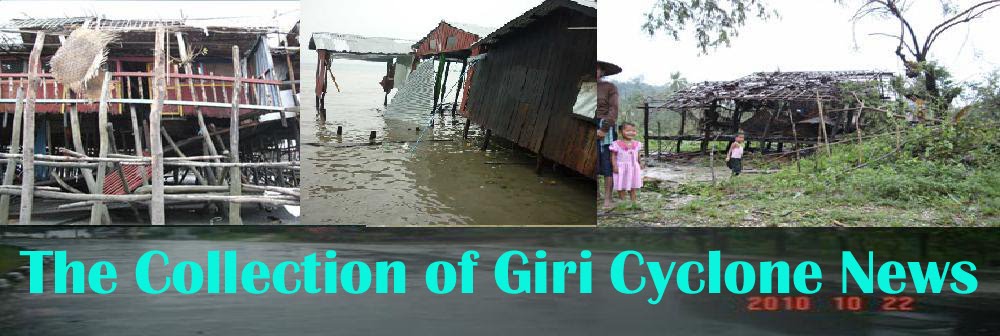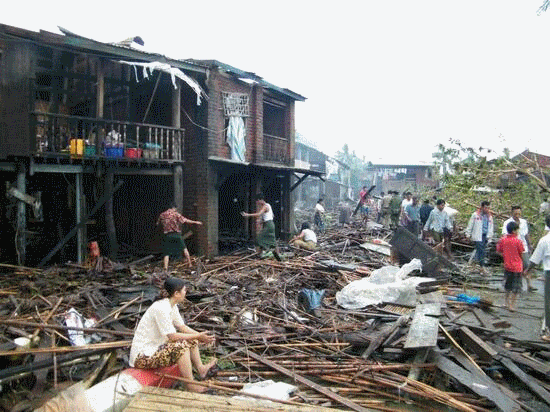
Winds have finally begun to subside along Burma’s cyclone-hit western coast but some 30 people are now thought to be dead or missing.
In the worst-hit areas of Kyaukphyu and Myebon towns in Arakan state, hundreds of houses were flattened as cyclone Giri hit the shoreline on Friday last week, with landfall wind strength thought to be higher than 2008’s cyclone Nargis.
“We heard that people were killed in Pyinwun village in Myebon township – there are about 30 people missing or dead,” a Kyaukphyu resident told DVB. “We guess that their buildings were swept along with the tidal waves.”
Many of the Kyaukphyu’s residents were however able to evacuate before the full force of the cyclone arrived, meaning casualties there were minimal. The resident said the town still bore a lot of damage.
“[It] began to get fierce around 3pm [on Friday] and people had already fled the town by 6pm. They left behind their houses and food stocks which were all destroyed by the cyclone.”
Estimates of the death toll have varied – one anonymous report circulated bycommunity groups in Arakan state puts the number confirmed at 17, with a further 50 hospitalised. It added that more than 70 percent of buildings in Kyaukphyu have been destroyed.
State media in Burma was slow to respond to the disaster, but an article in today’s New Light of Myanmar said that government ministers had visited the worst-hit towns.
“Today, they inspected clearing of debris in wards, and encouraged the victims at makeshift camp. There, they presented clothes, foodstuff, bottles of water, CI [corrugated iron] sheets, construction materials and cash assistance.”
The Arakan report said that swathes of agricultural land, as well as fishing boats and equipment, had also been badly damaged. Around 2,800 people left homeless by the storm were still waiting for aid. The report also criticised the slow response to the cyclone.
“There has still been very little assistance from international aid agencies, the government or Arakanese communities in the region for the homeless. Most of cyclone victims remain in desperate need of help for their basic needs of food and shelter,” it said.
Distribution of aid in Burma is notoriously poor, with the junta regularly restricting the movement of aid workers. Following cyclone Nargis in May 2008, which killed some 140,000 people, numbers of unofficial relief workers were imprisoned.
Burmese meteorologist Dr Tun Lwin said that another storm is likely to follow in the next month or so.
“I forecasted [last month] that about three to five [storms] would come in October and November,” he said. “So far there has already been four so there is about a 60 percent chance that at least one more storm will follow in November.”
http://www.dvb.no/news/death-toll-rises-on-cyclone-hit-coast/12396
In the worst-hit areas of Kyaukphyu and Myebon towns in Arakan state, hundreds of houses were flattened as cyclone Giri hit the shoreline on Friday last week, with landfall wind strength thought to be higher than 2008’s cyclone Nargis.
“We heard that people were killed in Pyinwun village in Myebon township – there are about 30 people missing or dead,” a Kyaukphyu resident told DVB. “We guess that their buildings were swept along with the tidal waves.”
Many of the Kyaukphyu’s residents were however able to evacuate before the full force of the cyclone arrived, meaning casualties there were minimal. The resident said the town still bore a lot of damage.
“[It] began to get fierce around 3pm [on Friday] and people had already fled the town by 6pm. They left behind their houses and food stocks which were all destroyed by the cyclone.”
Estimates of the death toll have varied – one anonymous report circulated bycommunity groups in Arakan state puts the number confirmed at 17, with a further 50 hospitalised. It added that more than 70 percent of buildings in Kyaukphyu have been destroyed.
State media in Burma was slow to respond to the disaster, but an article in today’s New Light of Myanmar said that government ministers had visited the worst-hit towns.
“Today, they inspected clearing of debris in wards, and encouraged the victims at makeshift camp. There, they presented clothes, foodstuff, bottles of water, CI [corrugated iron] sheets, construction materials and cash assistance.”
The Arakan report said that swathes of agricultural land, as well as fishing boats and equipment, had also been badly damaged. Around 2,800 people left homeless by the storm were still waiting for aid. The report also criticised the slow response to the cyclone.
“There has still been very little assistance from international aid agencies, the government or Arakanese communities in the region for the homeless. Most of cyclone victims remain in desperate need of help for their basic needs of food and shelter,” it said.
Distribution of aid in Burma is notoriously poor, with the junta regularly restricting the movement of aid workers. Following cyclone Nargis in May 2008, which killed some 140,000 people, numbers of unofficial relief workers were imprisoned.
Burmese meteorologist Dr Tun Lwin said that another storm is likely to follow in the next month or so.
“I forecasted [last month] that about three to five [storms] would come in October and November,” he said. “So far there has already been four so there is about a 60 percent chance that at least one more storm will follow in November.”
http://www.dvb.no/news/death-toll-rises-on-cyclone-hit-coast/12396





0 Responses to Death toll rises on cyclone-hit coast